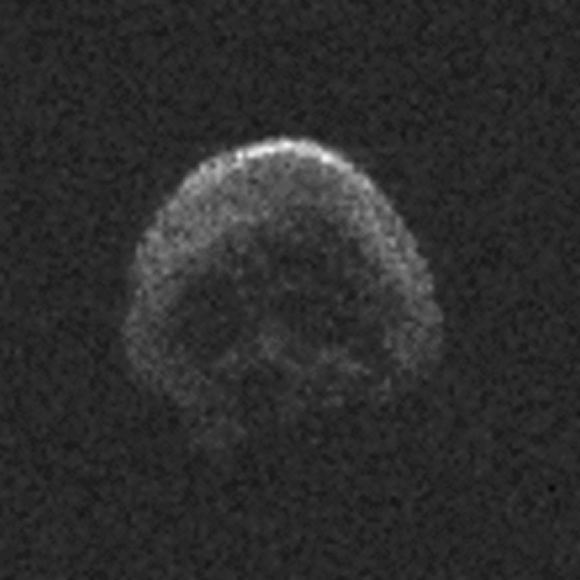On October 31st, 2015, NASA tracked a strange-looking comet as it made a close flyby of Earth. This asteroid, known as 2015 TB145, was monitored by the multiple observatories and radar installation of the agency’s Deep Space Network. Because of the timing and the skull-like appearance of this asteroid, scientists nicknamed it the “Death Comet”.
Naturally, there was no reason to worry, as the asteroid posed no threat and passed within about 498,900 km (310,000 mi) of Earth. But the timing and the appearance of the comet were nothing if not chilling. And coincidentally enough, the “Death Comet” (aka. “The Great Pumpkin Comet”), will be passing Earth for the second time, this time shortly after Halloween.
Asteroid 2015 TB145 was first discovered on Oct. 10th, 2015, by the Panoramic Survey Telescope and Rapid Response System (Pan-STARRS-1), part of the Near-Earth Object Observation (NEOO) program. At the time, the flyby of this asteroid – which measures 400 meters (1,300 feet) in diameter – was the closest flyby the asteroid made since 1999.
As Paul Chodas, the manager of the Center for Near Earth Object Studies at NASA’s Jet Propulsion Laboratory, indicated at the time:
“The trajectory of 2015 TB145 is well understood. At the point of closest approach, it will be no closer than about 300,000 miles — 480,000 kilometers or 1.3 lunar distances. Even though that is relatively close by celestial standards, it is expected to be fairly faint, so night-sky Earth observers would need at least a small telescope to view it.”
At the time, 2015 TB145 was determined to be a “dead comet”, meaning that it has shed its volatile elements (i.e. frozen water, carbon dioxide, ammonia, methane, etc.) after numerous passes around the Sun and no longer emits a tail. Combined with its skull-like appearance, which became evident thanks to radar images provided by the Arecibo Observatory, the comet quickly earned its nickname.
As Vishnu Reddy, a research scientist at the Planetary Science Institute (PSI), explained in a 2015 NASA news release:
“We found that the object reflects about 6 percent of the light it receives from the Sun. That is similar to fresh asphalt, and while here on Earth we think that is pretty dark, it is brighter than a typical comet which reflects only 3 to 5 percent of the light. That suggests it could be cometary in origin ? but as there is no coma evident, the conclusion is it is a dead comet.”

Once again, 2015 TB145 will pose no threat to life on Earth. According to the Mother Nature Network, it will make its closest pass to Earth on November 11th, reaching a distance of about 38.6 million km (24 million mi) from the surface. This is roughly one-hundred times the average distance between the Earth and the Moon (384,399 km; 238,855 mi), or a quarter of the distance between the Earth and the Sun (149.6 million km; 93 million mi).
It’s also worth noting that this is precisely what NASA’s Near-Earth Object Observations Program predicted back in 2015, based on their tracking of the comets orbit. The next closest pass will take place on November 1st, 2088, and at a distance of just over 8 million km (5 million mi). So as spooky as this comet’s appearance and timing may appear to be, there’s really no reason to worry.
Sorry, apocalypse enthusiasts, but once again, the end is not nigh.


“This is roughly ten times the average distance between the Earth and the Moon”
Above line needs a correction! 38 million km is 100 times the Earth-Moon distance, not 10 times.
Thanks for pointing it out. Corrected! 🙂